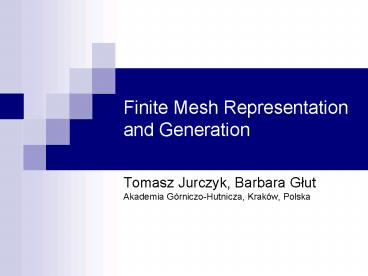Finite Mesh Representation and Generation - PowerPoint PPT Presentation
1 / 37
Title:
Finite Mesh Representation and Generation
Description:
Finite Mesh Representation and Generation. Tomasz Jurczyk, Barbara Glut ... for cases Q1, Q100, QN/3. 23. Computational complexity ... – PowerPoint PPT presentation
Number of Views:42
Avg rating:3.0/5.0
Title: Finite Mesh Representation and Generation
1
Finite Mesh Representation and Generation
- Tomasz Jurczyk, Barbara Glut Akademia
Górniczo-Hutnicza, Kraków, Polska
2
Outline
- Introduction
- Overview of mesh generation process
- Mesh representation and algorithms
- Control space structure
- Efficiency and numerical robustness
- Examples
3
IntroductionDiscretization process
B-REP geometry
Surface mesh
Volume mesh
4
IntroductionAdditional meshing operations
Automatic recognition ofgeometrical features
Conversion to quadrilateral mesh
5
IntroductionAdditional meshing operations
Decomposition
Adaptation
6
IntroductionRequirements
- High quality of elements
- Accurate fulfillment of the user specified
sizing information - Smooth transitions
- Automatic recognition of geometrical features
of the domain - Efficiency
- Robustness
7
Mesh representation
Full representation for tetrahedral mesh
Minimum representation
8
Mesh representation
Element3d
Face3d
Element2d
Edge3d
Edge2d
Vertex3d
Vertex2d
Representation selected for volume meshes
Representation selected for surface meshes
9
Mesh representationTradeoff example
Element2d
Edge2d
Surface triangular mesh 50.7k
Vertex2d
10
Mesh representationAttributes of mesh entities
- Vertex2d
- coordinates
- metric_coordinates
- index
- border_info
- adjacent_edges
- vertex3d
- extended_data
- Tetrahedron
- index
- area_id
- quality
- vertices
- adjacent_faces
- extended_data
- Edge2d
- shape
- shape_params
- border_type
- level
- vertices
- adjacent_elements
- inner_vertices
- edge3d
- extended_data
11
Mesh OperationsBasic
Edge swap
Adjacent elements
Swap23
Ordered edges
12
Mesh OperationsDelaunay retriangulation
Criterion of empty circumsphere
Criterion of inner angles
13
Mesh OperationsConversion to quads
Forming of new quad
14
Geometrical Primitives
- Most important
- InCircumcircle (InCircumsphere)
- Orient2D (Orient3D)
- Adaptive precision
- Other
- circumcenter,
- edge-edge cross,
- edge-face cross...
15
Metric DefinitionControl Space
- 2D form in parametric space of each patch
- 3D form for volumes
- Mesh elements
- anisotropic
16
Definition of Control SpaceAdaptive structure
Quadtree (Octree)
Background mesh
17
Control SpaceOperations
a) initialization of nodes
b) adaptation of structure
c) postprocessing
d) combining several structures
e) adjusting gradation
Utilization
18
Metric Operations
Interpolation
Intersection
19
Mesh representationStorage
- Prediction of final number of entities for each
phase of generation - Batch allocation and deallocation of entities
Number of entities during the process of mesh
generation(mesh with NT49k and NT194k)
20
Mesh representationStorage
- Delayed removal of entities
Local variation of the number of mesh
entities (edges) during triangulation process
21
Prediction of Mesh Sizefor Delaunay triangulation
- predicted number of triangles
- current number of triangles in the mesh
- quality coefficient of the ideal triangle
- quality coefficient of the selected triangle
22
Prediction of Mesh Sizefor Delaunay triangulation
Accuracy of prediction (ratio of assessed final
number of elementsto the real value) against the
triangulation progress, for cases Q1, Q100, QN/3
23
Computational complexity
Computational complexity for meshes with the
final number of triangles NT12580, NT48796,
NT193672
24
Examples
25
Examples
26
Examples
27
Examples
28
Examples
29
Summary
- Fully automatic construction of triangular and
quadrilateral (anisotropic if required) good
quality 3D meshes - Robust and efficient
- Automated adaptation of mesh structure to
constraints introduced by model geometry and/or
user specification - Extendability (object-oriented programming)
30
Thank you!
31
DecompositionOverview of Method
- input data
- surface mesh
- selection of the separator surface (plane)
32
DecompositionOverview of Method
- localization of triangles cut by the separator
- surface mesh split into three parts
33
DecompositionOverview of Method
- determination of the interface contour
- construction of 2D mesh on the separator plane
- lifting of planar mesh boundary to close the 3D
subdomain meshes
34
DecompositionOverview of Method
- closing of the subdomains
35
Delaunay triangulation Finding the containing
triangle
Oriented traversing of elements
Selection of edge in the direction of the
inserted point
36
Delaunay triangulation Finding the containing
triangle
Choosing the preferred triangle for the tree node
Scanning the tree along the path determined by
the given point
37
Meshing with Metric Conversion anisotropic mesh































